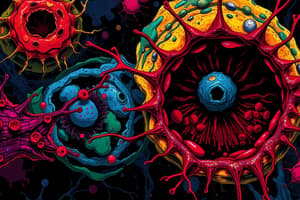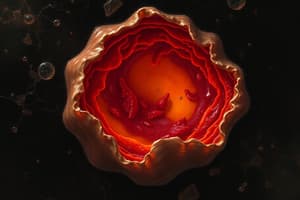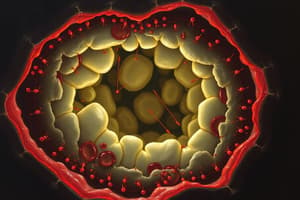Podcast
Questions and Answers
Which condition is characterized by a putrid and foul-smelling presentation with rapid proximal spread and no clear line of demarcation?
Which condition is characterized by a putrid and foul-smelling presentation with rapid proximal spread and no clear line of demarcation?
- Dry Ischaemic gangrene
- Apoptosis
- Autophagy
- Wet Ischaemic gangrene (correct)
What is a key physiological role of apoptosis?
What is a key physiological role of apoptosis?
- Atrophy of organs following obstruction
- Induction of immune cell proliferation
- Promotion of tumor growth
- Cell deletion in proliferating tissues (correct)
Which of the following is NOT associated with reduced apoptosis?
Which of the following is NOT associated with reduced apoptosis?
- Neoplasia involving p53 mutations
- Increased cell turnover (correct)
- Bcl-2 overexpression
- Cell accumulation
What type of cell death is characterized by the digestion of cellular organelles for energy, particularly in starving cells?
What type of cell death is characterized by the digestion of cellular organelles for energy, particularly in starving cells?
Which of the following diseases is associated with increased apoptosis leading to cell loss?
Which of the following diseases is associated with increased apoptosis leading to cell loss?
What differentiates dry ischaemic gangrene from wet ischaemic gangrene?
What differentiates dry ischaemic gangrene from wet ischaemic gangrene?
Which enzyme is primarily responsible for the fragmentation of DNA during apoptosis?
Which enzyme is primarily responsible for the fragmentation of DNA during apoptosis?
What is the potential outcome if nutrients are not received by a cell undergoing autophagy?
What is the potential outcome if nutrients are not received by a cell undergoing autophagy?
Which form of cell death is often linked with graft versus host disease?
Which form of cell death is often linked with graft versus host disease?
Which characteristic is NOT typically associated with necroptosis?
Which characteristic is NOT typically associated with necroptosis?
What is the primary mechanism that leads to liquefactive necrosis?
What is the primary mechanism that leads to liquefactive necrosis?
Which condition is most commonly associated with caseative necrosis?
Which condition is most commonly associated with caseative necrosis?
What is one of the causes of fat necrosis?
What is one of the causes of fat necrosis?
Which of the following cellular reactions is characterized by fragmented granular debris surrounded by epithelioid histiocytes?
Which of the following cellular reactions is characterized by fragmented granular debris surrounded by epithelioid histiocytes?
What pathological process primarily contributes to the formation of calcium soaps in fat necrosis?
What pathological process primarily contributes to the formation of calcium soaps in fat necrosis?
What distinguishes necroptosis from apoptosis?
What distinguishes necroptosis from apoptosis?
Which tissue is particularly susceptible to liquefactive necrosis due to its high water content?
Which tissue is particularly susceptible to liquefactive necrosis due to its high water content?
In which scenario would you expect to see shadowy outlines of necrotic fat cells?
In which scenario would you expect to see shadowy outlines of necrotic fat cells?
What type of cell death is characterized by the induction of inflammation due to cell lysis?
What type of cell death is characterized by the induction of inflammation due to cell lysis?
Which of the following necrosis types is most commonly associated with acute pancreatitis?
Which of the following necrosis types is most commonly associated with acute pancreatitis?
Which process is characterized by the programmed death of cells without causing inflammation?
Which process is characterized by the programmed death of cells without causing inflammation?
Which type of necrosis features the preservation of the cell's basic shape but loss of the nucleus?
Which type of necrosis features the preservation of the cell's basic shape but loss of the nucleus?
Which type of necrosis is most commonly associated with bacterial infections?
Which type of necrosis is most commonly associated with bacterial infections?
Which type of cell death is specifically related to the formation of gas gangrene?
Which type of cell death is specifically related to the formation of gas gangrene?
What is the primary mechanism through which cellular components are degraded in autophagy?
What is the primary mechanism through which cellular components are degraded in autophagy?
Which statement correctly differentiates pyroptosis from other forms of cell death?
Which statement correctly differentiates pyroptosis from other forms of cell death?
What is the main characteristic feature of gangrene?
What is the main characteristic feature of gangrene?
Which drugs or substances are most likely to induce apoptosis as a therapeutic mechanism?
Which drugs or substances are most likely to induce apoptosis as a therapeutic mechanism?
Which physical factor can potentially lead to necrosis by causing damage through extreme conditions?
Which physical factor can potentially lead to necrosis by causing damage through extreme conditions?
What type of cells are typically observed microscopically in traumatic fat necrosis?
What type of cells are typically observed microscopically in traumatic fat necrosis?
Which microbe is primarily associated with primary gas gangrene?
Which microbe is primarily associated with primary gas gangrene?
Which condition is NOT a cause of secondary or ischaemic gangrene?
Which condition is NOT a cause of secondary or ischaemic gangrene?
What is the primary characteristic of gangrene?
What is the primary characteristic of gangrene?
Which of the following best describes the process of gas gangrene?
Which of the following best describes the process of gas gangrene?
What type of necrosis is characterized by a hard mass in fat tissue due to trauma?
What type of necrosis is characterized by a hard mass in fat tissue due to trauma?
Which factor is most closely linked to the development of secondary (ischaemic) gangrene?
Which factor is most closely linked to the development of secondary (ischaemic) gangrene?
What is a common sign of gas gangrene during physical examination?
What is a common sign of gas gangrene during physical examination?
Which term refers specifically to necrosis accompanied by putrefaction due to bacterial action?
Which term refers specifically to necrosis accompanied by putrefaction due to bacterial action?
What type of bacteria is commonly involved in primary gangrene and associated with soil?
What type of bacteria is commonly involved in primary gangrene and associated with soil?
Flashcards
Necrosis
Necrosis
The death of cells within a living organism caused by protein denaturation and/or enzymatic digestion. This is a breakdown of the cell from the inside out.
Autolysis
Autolysis
The process by which a cell is broken down by its own enzymes, specifically from lysosomes.
Gangrene
Gangrene
A condition where dead tissue is digested by bacteria, causing putrefaction in a body part.
Primary Gangrene
Primary Gangrene
Signup and view all the flashcards
Secondary Gangrene
Secondary Gangrene
Signup and view all the flashcards
Gas Gangrene
Gas Gangrene
Signup and view all the flashcards
Dry Gangrene
Dry Gangrene
Signup and view all the flashcards
Wet Gangrene
Wet Gangrene
Signup and view all the flashcards
Vascular disease
Vascular disease
Signup and view all the flashcards
Embolism
Embolism
Signup and view all the flashcards
Trauma to a major artery
Trauma to a major artery
Signup and view all the flashcards
Frostbite
Frostbite
Signup and view all the flashcards
Liquefactive Necrosis
Liquefactive Necrosis
Signup and view all the flashcards
Brain Infarction and Liquefactive Necrosis
Brain Infarction and Liquefactive Necrosis
Signup and view all the flashcards
Caseous Necrosis
Caseous Necrosis
Signup and view all the flashcards
Caseous Necrosis in Tuberculosis
Caseous Necrosis in Tuberculosis
Signup and view all the flashcards
Microscopic Features of Caseous Necrosis
Microscopic Features of Caseous Necrosis
Signup and view all the flashcards
Fat Necrosis
Fat Necrosis
Signup and view all the flashcards
Enzymatic Fat Necrosis
Enzymatic Fat Necrosis
Signup and view all the flashcards
Causes of Enzymatic Fat Necrosis
Causes of Enzymatic Fat Necrosis
Signup and view all the flashcards
Calcium Soaps in Fat Necrosis
Calcium Soaps in Fat Necrosis
Signup and view all the flashcards
Traumatic Fat Necrosis
Traumatic Fat Necrosis
Signup and view all the flashcards
What is apoptosis?
What is apoptosis?
Signup and view all the flashcards
What does carbolic acid cause?
What does carbolic acid cause?
Signup and view all the flashcards
What does ergot cause?
What does ergot cause?
Signup and view all the flashcards
Describe dry gangrene.
Describe dry gangrene.
Signup and view all the flashcards
Describe wet gangrene.
Describe wet gangrene.
Signup and view all the flashcards
What are the physiological functions of apoptosis?
What are the physiological functions of apoptosis?
Signup and view all the flashcards
What are the pathological roles of apoptosis?
What are the pathological roles of apoptosis?
Signup and view all the flashcards
How can apoptosis be related to diseases?
How can apoptosis be related to diseases?
Signup and view all the flashcards
What is autophagy?
What is autophagy?
Signup and view all the flashcards
What happens if autophagy continues without nutrient restoration?
What happens if autophagy continues without nutrient restoration?
Signup and view all the flashcards
Study Notes
Cell Death Overview
- A lecture by Dr. Alessandro Aldera, Division of Anatomical Pathology, University of Cape Town, February 2024.
- Topics covered include necrosis, gangrene, apoptosis, and new concepts.
Necrosis
-
Definition: Death of cells in a living organism due to protein denaturation and/or enzymatic digestion of the cell.
-
Autolysis: Cellular enzymatic degradation by catalytic enzymes from the lysosomes of dead cells.
-
Heterolysis: Enzymatic degradation by enzymes from immigrant and living cells such as neutrophils and macrophages.
-
Causes:
- Ischemia (e.g., infarcts, center of tumors, hypoxia).
- Toxins (e.g., snake venom, bacterial toxins).
- Infections (e.g., viruses like polio, hepatitis; bacteria like diphtheria, typhoid).
- hypersensitivity reactions (e.g., caseative necrosis in tuberculosis).
- Chemical poisons (e.g., acids, alkalis, phenols)
- physical factors, such as irradiation, high heat (>45°C), freezing (resulting in vasospasm and ice crystals)
-
Types of Necrosis:
- Coagulative necrosis: preservation of basic cell shape, loss of nuclei, eosinophilic (pink/opaque) cytoplasm, due to protein denaturation (seen in most tissues except brain).
- Liquifactive necrosis: liquefaction of tissues due to lytic enzymes, characteristic of brain infarcts and abscesses (neutrophils).
- Caseous necrosis: friable, yellow-white debris similar to cheese, found in tuberculosis hypersensitivity reactions.
- Fat necrosis: enzymatic (e.g., acute pancreatitis from alcohol or bile reflux/regurgitation), traumatic (e.g., from injections), or infectious; results in calcium soaps (saponification).
-
See different examples under each type for further details.
Gangrene
-
Definition: Necrosis with putrefaction of tissues (tissue digestion by bacterial action)
-
Classification:
- Primary: Due to infection with pathogenic bacteria that kill tissues (exotoxins) and then invade/digest dead tissue (e.g., gas gangrene from Clostridium perfringens, intestinal commensal, found in soil).
- Secondary/Ischemic: Tissue necrosis due to another cause, following ischemia (e.g., vascular disease, atherosclerosis, diabetes; embolism [e.g., left heart atrium, ventricle valves, infective endocarditis], trauma to major artery).
-
Types of Gangrene (illustrated in images):
- Dry gangrene (ischemic): initially in toes, spreads proximally, shrivelled, dry, mummified, sharp line of demarcation, black (iron sulphide)
- Wet gangrene (ischemic): foul smelling, rapid proximal spread, no clear line of demarcation.
Apoptosis
- Definition: A programmed pathway of cell death that uses regulated intracellular programs to activate enzymes that destroy DNA and cell proteins.
- Mechanism:
- Energy-dependent fragmentation of DNA by endogenous endonucleases
- Individual cell deletion of unwanted/defective cells due to physiological and pathological circumstances.
- Function/Roles:
- Physiological: Embryogenesis, hormone-dependent involution, cell deletion in proliferating tissues (e.g., intestine), prevents genome instability.
- Pathological: Cell death in tumours, death of immune cells (B and T lymphocytes), atrophy of hormone-dependent and obstructed organs, cell death from cytotoxic T cells (e.g., graft rejection, graft vs. host disease), cell injury by viruses.
- Illustrated examples of the process of Apoptosis
Autophagy
- Proposed third mode of cell death: Cells generate energy and metabolites by digesting their own organelles and macromolecules. A starvation response can be used to allow a surviving cell and subsequently, may potentially digest all cellular substrates and die.
Necroptosis
- Definition: A form of programmed cell death. Morphologically resembles necrosis and mechanistically resembles apoptosis. This mode is genetically programmed and caspase-independent.
Pyroptosis
- Definition: Another form of programmed cell death marked by the release of fever-inducing pyrogens (IL-1)
- Mechanism: Cells swell, cause a loss of plasma membrane integrity, and release inflammatory mediators.
- Association/Occurrence: Primarily occurs in cells infected by microbes/pathogens.
Studying That Suits You
Use AI to generate personalized quizzes and flashcards to suit your learning preferences.




